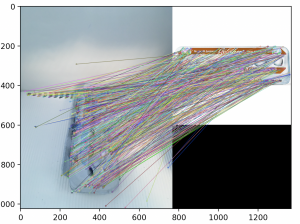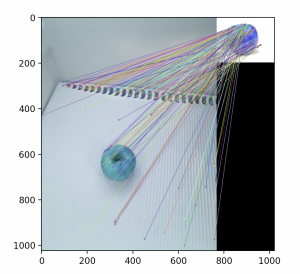My major task for the week was to benchmark the various potential CV algorithms, and determine which to use moving forward. Unfortunately, I failed in this regard. While I was able to benchmark the various algorithms, I was unable to draw any sort of meaningful argument as to which is superior.
My process for doing benchmarking was fairly simple. I manually took a number of photos of the items on our list, with an iphone camera. These will vary slightly from the images which will be taken with the RPI (fisheye lens from a slightly different angle) but should be sufficient for testing purposes. The inside of the fridge I used for an example also has a small amount of visual clutter. I manually created a bounding box for each of the images I took, in order to determine what number of good matches we observe. Since Sift/Fast/Orb all inherent from the same superclass, the algorithm to use could simply be passed as an argument. After creating the code and debugging, I ran into an immediate problem. All the algorithms seemed to have vastly more failure matchings for the less geometrically complicated items then what I was expecting going in. The items with labels also were performed quite poorly when the labels were obscured (which was expected). I made a simple sanity check that highlighted the matches, the results of which I show below:





I’ve only shown the results with SIFT, but the results for FAST/ORB were generally as bad if not worse. I expect that the errors are likely due to what I previously had considered “very minor” background clutter, judging by the number of false matches with the ridges in the back. SIFT won for most of the categories, but I can’t feel confident with the results until it’s repeated in an environment with less background noise, and we are able to get something resembling the number of correct matches required for our use case. In the future, I will do an eyeball check before bothering with manually adding bounding boxes. I did a few eyeball checks while using various preprocessing tools, but none had a significant effect as far as I could see. I’m uncertain how to handle the label being obscured/non-visible, as this will likely pose a greater problem going forward.
Ultimately, I think this week was a failure on my part, and has in no way helped our being behind. The issues encountered here must be addressed quickly, as all other aspects of the project are dependent on it. As such, both myself and Harry will be working on it come next week. I hope, by next week, to have actually finished this, and have a solid answer. Concurrent with this, I hope to develop a standardized testing method, so we can more easily fine tune later. I hope to also investigate how best to mitigate the labeling issue, and provide a reasonable fix for this.
Current code/images used can be found at: https://github.com/keatoooon/test_stuff
